Fonterra in China: A PESTLE and SWOT Analysis of Market Entry
VerifiedAdded on 2023/04/05
|21
|4085
|278
Report
AI Summary
This report examines Fonterra's business ventures in China, outlining the motives, stakeholder relationships, and market-driven benefits within the OLI framework. A PESTLE analysis identifies key external factors impacting operations, while Porter's five forces model assesses the competitive landscape. The SWOT analysis reveals Fonterra's internal strengths and weaknesses, including financial resources and ethical concerns. The report concludes with strategic recommendations for Fonterra, such as product development and cost leadership, to enhance market penetration and competitive advantage in the Chinese market. Desklib provides students with access to this assignment solution along with other study resources.
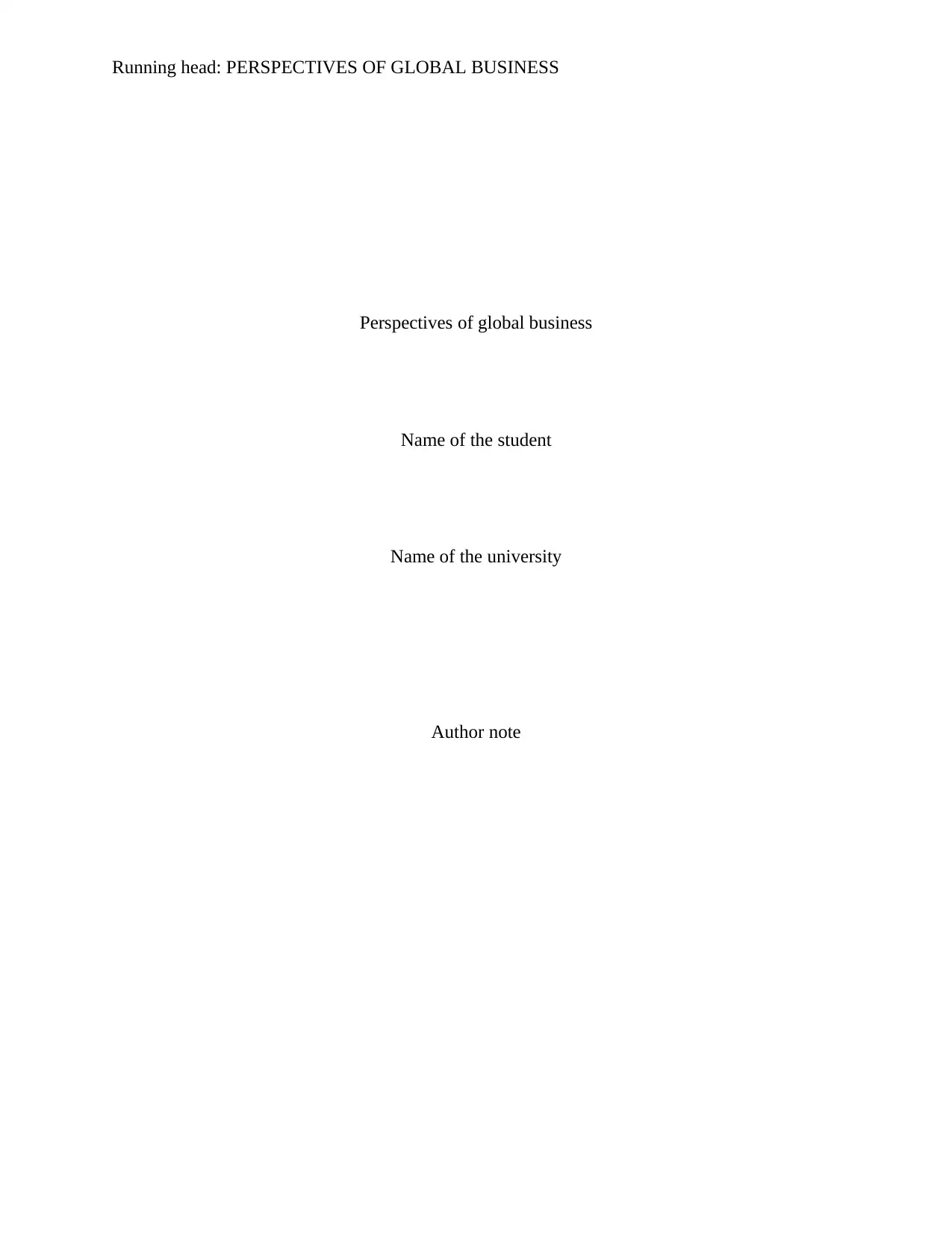
Running head: PERSPECTIVES OF GLOBAL BUSINESS
Perspectives of global business
Name of the student
Name of the university
Author note
Perspectives of global business
Name of the student
Name of the university
Author note
Paraphrase This Document
Need a fresh take? Get an instant paraphrase of this document with our AI Paraphraser
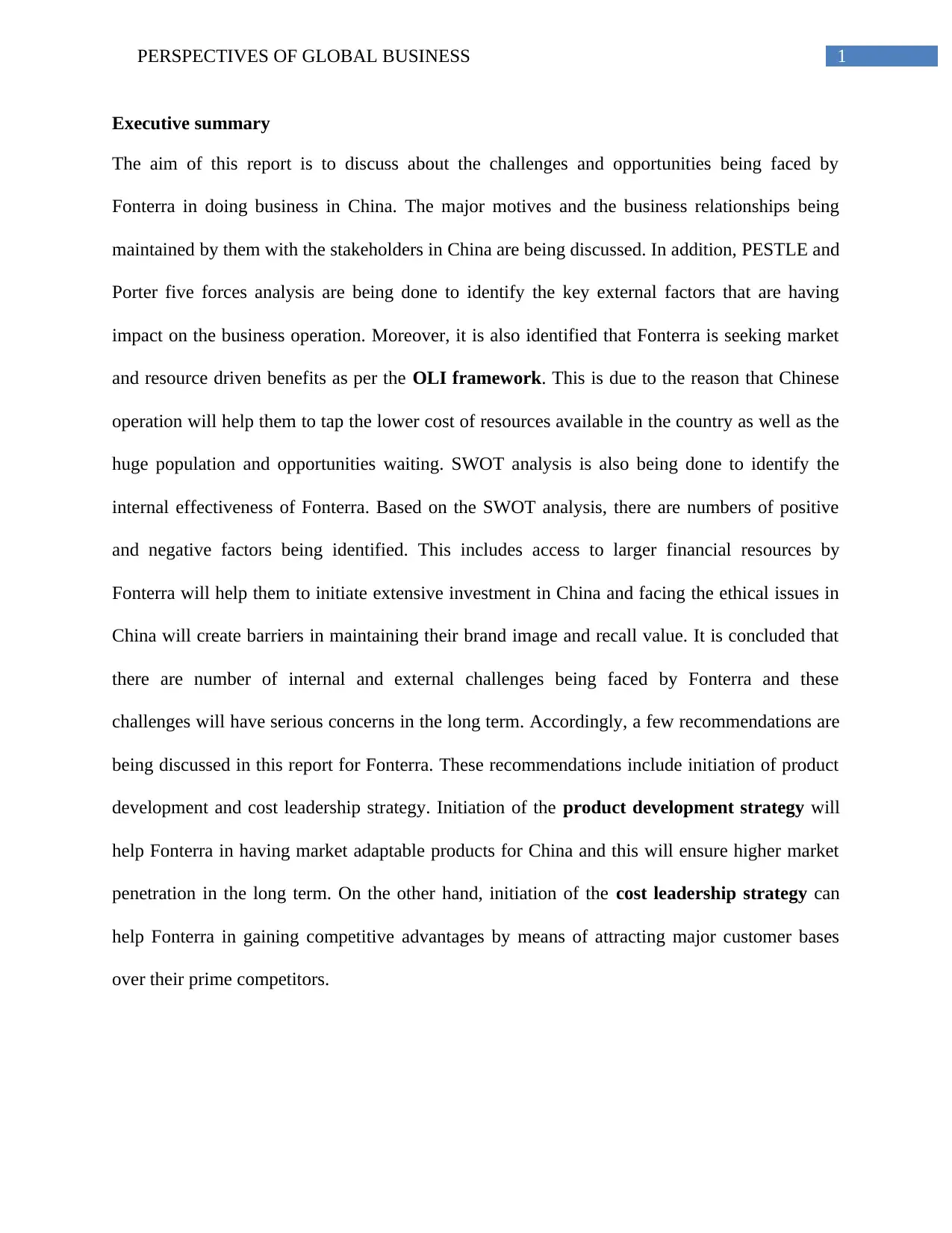
1PERSPECTIVES OF GLOBAL BUSINESS
Executive summary
The aim of this report is to discuss about the challenges and opportunities being faced by
Fonterra in doing business in China. The major motives and the business relationships being
maintained by them with the stakeholders in China are being discussed. In addition, PESTLE and
Porter five forces analysis are being done to identify the key external factors that are having
impact on the business operation. Moreover, it is also identified that Fonterra is seeking market
and resource driven benefits as per the OLI framework. This is due to the reason that Chinese
operation will help them to tap the lower cost of resources available in the country as well as the
huge population and opportunities waiting. SWOT analysis is also being done to identify the
internal effectiveness of Fonterra. Based on the SWOT analysis, there are numbers of positive
and negative factors being identified. This includes access to larger financial resources by
Fonterra will help them to initiate extensive investment in China and facing the ethical issues in
China will create barriers in maintaining their brand image and recall value. It is concluded that
there are number of internal and external challenges being faced by Fonterra and these
challenges will have serious concerns in the long term. Accordingly, a few recommendations are
being discussed in this report for Fonterra. These recommendations include initiation of product
development and cost leadership strategy. Initiation of the product development strategy will
help Fonterra in having market adaptable products for China and this will ensure higher market
penetration in the long term. On the other hand, initiation of the cost leadership strategy can
help Fonterra in gaining competitive advantages by means of attracting major customer bases
over their prime competitors.
Executive summary
The aim of this report is to discuss about the challenges and opportunities being faced by
Fonterra in doing business in China. The major motives and the business relationships being
maintained by them with the stakeholders in China are being discussed. In addition, PESTLE and
Porter five forces analysis are being done to identify the key external factors that are having
impact on the business operation. Moreover, it is also identified that Fonterra is seeking market
and resource driven benefits as per the OLI framework. This is due to the reason that Chinese
operation will help them to tap the lower cost of resources available in the country as well as the
huge population and opportunities waiting. SWOT analysis is also being done to identify the
internal effectiveness of Fonterra. Based on the SWOT analysis, there are numbers of positive
and negative factors being identified. This includes access to larger financial resources by
Fonterra will help them to initiate extensive investment in China and facing the ethical issues in
China will create barriers in maintaining their brand image and recall value. It is concluded that
there are number of internal and external challenges being faced by Fonterra and these
challenges will have serious concerns in the long term. Accordingly, a few recommendations are
being discussed in this report for Fonterra. These recommendations include initiation of product
development and cost leadership strategy. Initiation of the product development strategy will
help Fonterra in having market adaptable products for China and this will ensure higher market
penetration in the long term. On the other hand, initiation of the cost leadership strategy can
help Fonterra in gaining competitive advantages by means of attracting major customer bases
over their prime competitors.
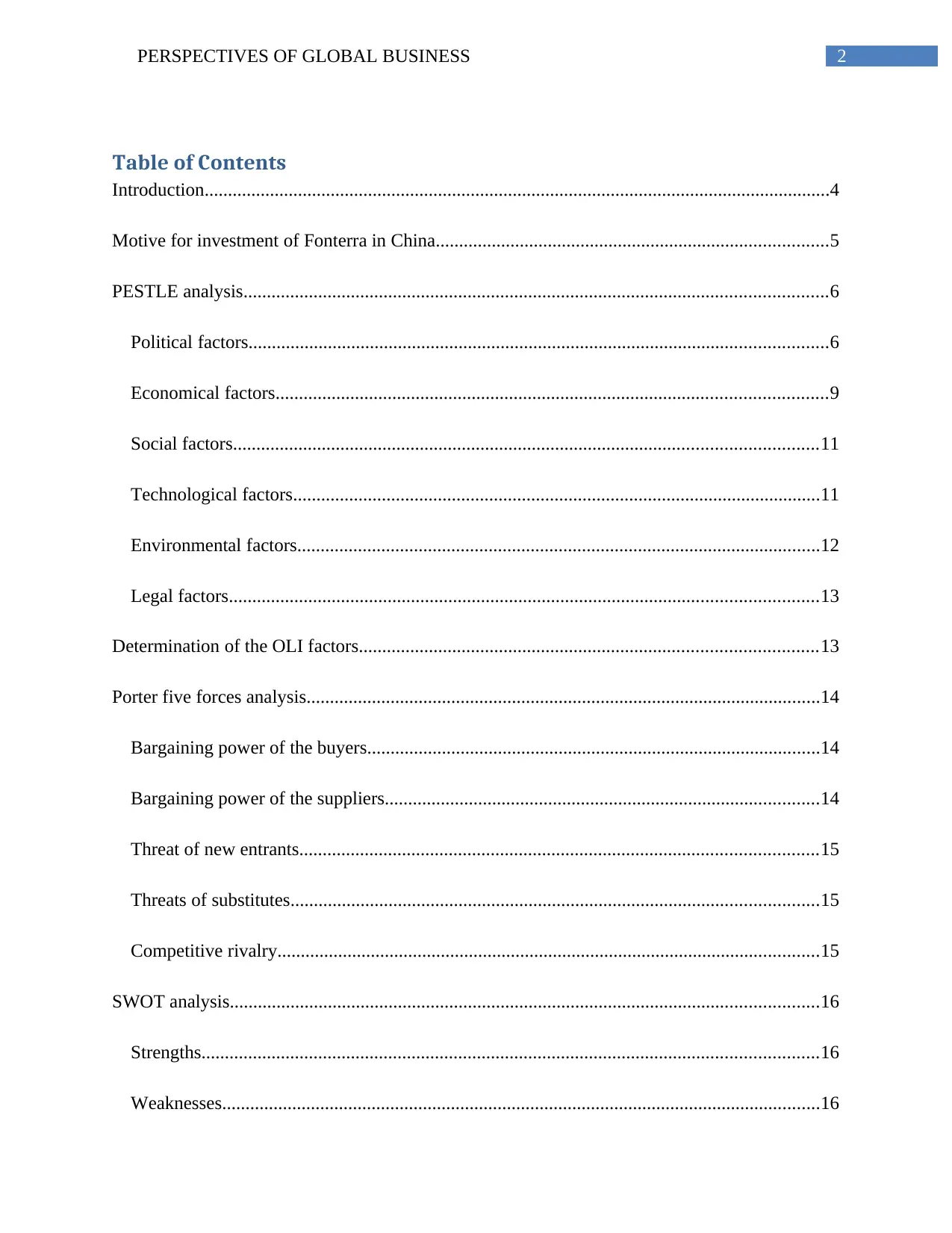
2PERSPECTIVES OF GLOBAL BUSINESS
Table of Contents
Introduction......................................................................................................................................4
Motive for investment of Fonterra in China....................................................................................5
PESTLE analysis.............................................................................................................................6
Political factors............................................................................................................................6
Economical factors......................................................................................................................9
Social factors.............................................................................................................................11
Technological factors.................................................................................................................11
Environmental factors................................................................................................................12
Legal factors..............................................................................................................................13
Determination of the OLI factors..................................................................................................13
Porter five forces analysis..............................................................................................................14
Bargaining power of the buyers.................................................................................................14
Bargaining power of the suppliers.............................................................................................14
Threat of new entrants...............................................................................................................15
Threats of substitutes.................................................................................................................15
Competitive rivalry....................................................................................................................15
SWOT analysis..............................................................................................................................16
Strengths....................................................................................................................................16
Weaknesses................................................................................................................................16
Table of Contents
Introduction......................................................................................................................................4
Motive for investment of Fonterra in China....................................................................................5
PESTLE analysis.............................................................................................................................6
Political factors............................................................................................................................6
Economical factors......................................................................................................................9
Social factors.............................................................................................................................11
Technological factors.................................................................................................................11
Environmental factors................................................................................................................12
Legal factors..............................................................................................................................13
Determination of the OLI factors..................................................................................................13
Porter five forces analysis..............................................................................................................14
Bargaining power of the buyers.................................................................................................14
Bargaining power of the suppliers.............................................................................................14
Threat of new entrants...............................................................................................................15
Threats of substitutes.................................................................................................................15
Competitive rivalry....................................................................................................................15
SWOT analysis..............................................................................................................................16
Strengths....................................................................................................................................16
Weaknesses................................................................................................................................16
⊘ This is a preview!⊘
Do you want full access?
Subscribe today to unlock all pages.

Trusted by 1+ million students worldwide
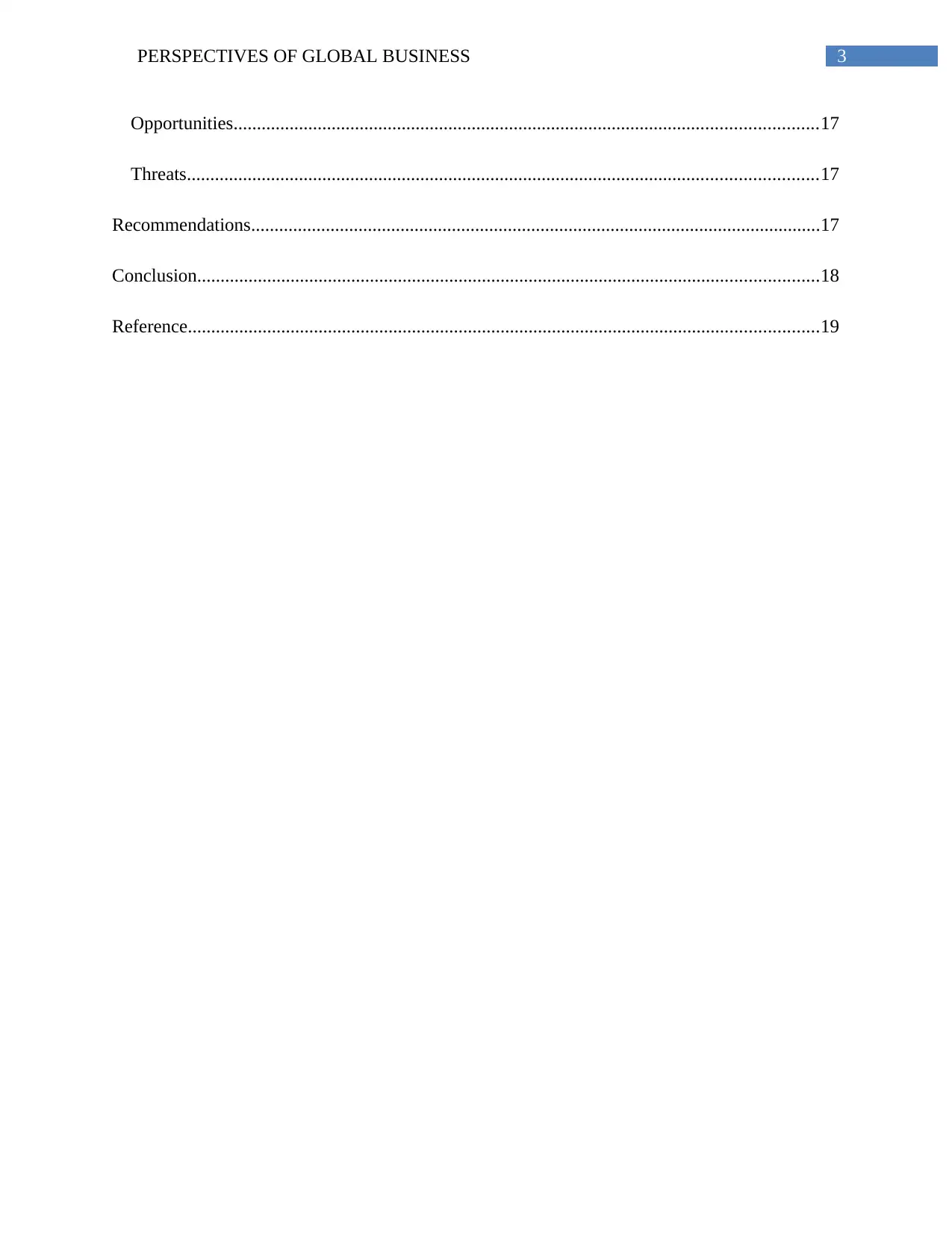
3PERSPECTIVES OF GLOBAL BUSINESS
Opportunities.............................................................................................................................17
Threats.......................................................................................................................................17
Recommendations..........................................................................................................................17
Conclusion.....................................................................................................................................18
Reference.......................................................................................................................................19
Opportunities.............................................................................................................................17
Threats.......................................................................................................................................17
Recommendations..........................................................................................................................17
Conclusion.....................................................................................................................................18
Reference.......................................................................................................................................19
Paraphrase This Document
Need a fresh take? Get an instant paraphrase of this document with our AI Paraphraser
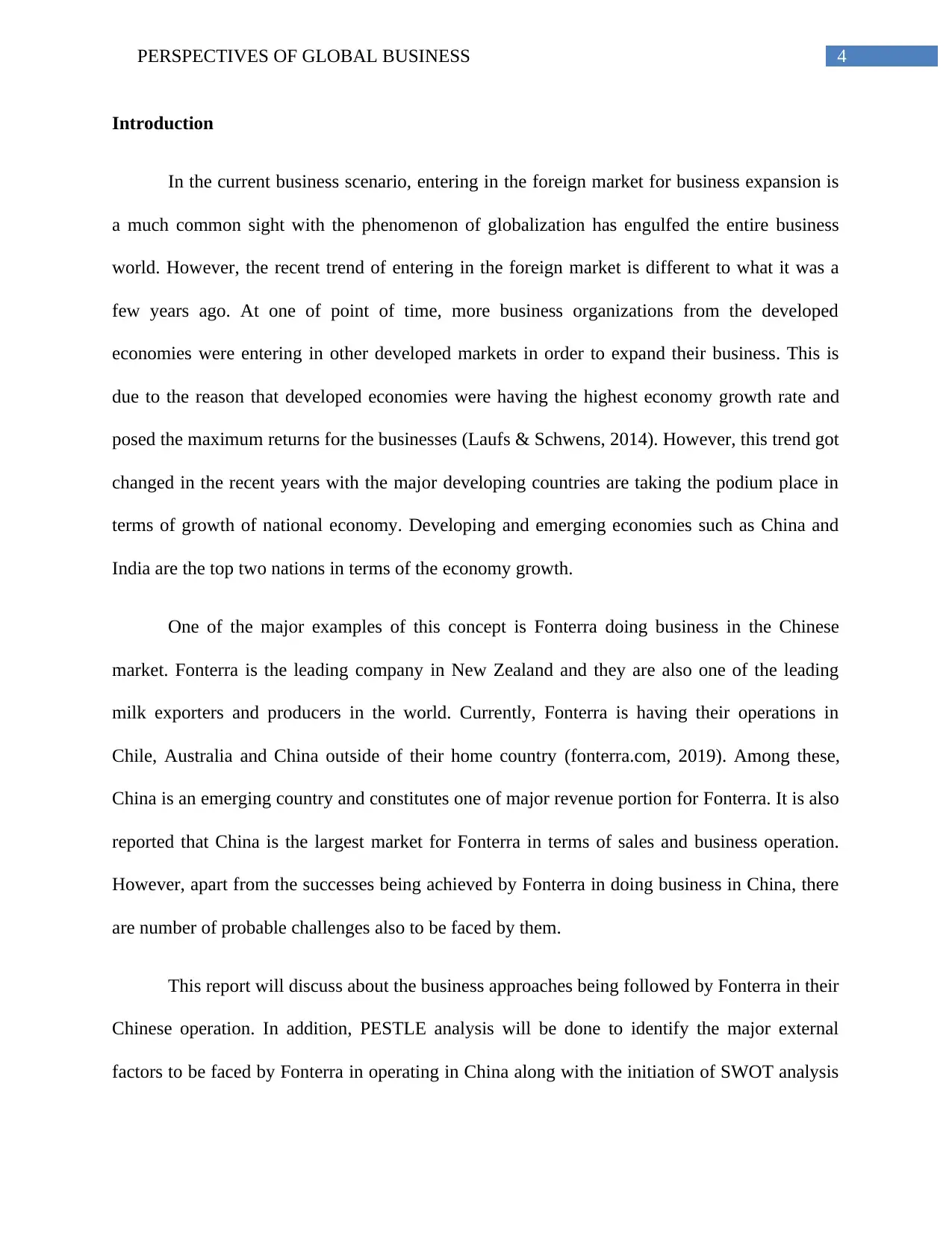
4PERSPECTIVES OF GLOBAL BUSINESS
Introduction
In the current business scenario, entering in the foreign market for business expansion is
a much common sight with the phenomenon of globalization has engulfed the entire business
world. However, the recent trend of entering in the foreign market is different to what it was a
few years ago. At one of point of time, more business organizations from the developed
economies were entering in other developed markets in order to expand their business. This is
due to the reason that developed economies were having the highest economy growth rate and
posed the maximum returns for the businesses (Laufs & Schwens, 2014). However, this trend got
changed in the recent years with the major developing countries are taking the podium place in
terms of growth of national economy. Developing and emerging economies such as China and
India are the top two nations in terms of the economy growth.
One of the major examples of this concept is Fonterra doing business in the Chinese
market. Fonterra is the leading company in New Zealand and they are also one of the leading
milk exporters and producers in the world. Currently, Fonterra is having their operations in
Chile, Australia and China outside of their home country (fonterra.com, 2019). Among these,
China is an emerging country and constitutes one of major revenue portion for Fonterra. It is also
reported that China is the largest market for Fonterra in terms of sales and business operation.
However, apart from the successes being achieved by Fonterra in doing business in China, there
are number of probable challenges also to be faced by them.
This report will discuss about the business approaches being followed by Fonterra in their
Chinese operation. In addition, PESTLE analysis will be done to identify the major external
factors to be faced by Fonterra in operating in China along with the initiation of SWOT analysis
Introduction
In the current business scenario, entering in the foreign market for business expansion is
a much common sight with the phenomenon of globalization has engulfed the entire business
world. However, the recent trend of entering in the foreign market is different to what it was a
few years ago. At one of point of time, more business organizations from the developed
economies were entering in other developed markets in order to expand their business. This is
due to the reason that developed economies were having the highest economy growth rate and
posed the maximum returns for the businesses (Laufs & Schwens, 2014). However, this trend got
changed in the recent years with the major developing countries are taking the podium place in
terms of growth of national economy. Developing and emerging economies such as China and
India are the top two nations in terms of the economy growth.
One of the major examples of this concept is Fonterra doing business in the Chinese
market. Fonterra is the leading company in New Zealand and they are also one of the leading
milk exporters and producers in the world. Currently, Fonterra is having their operations in
Chile, Australia and China outside of their home country (fonterra.com, 2019). Among these,
China is an emerging country and constitutes one of major revenue portion for Fonterra. It is also
reported that China is the largest market for Fonterra in terms of sales and business operation.
However, apart from the successes being achieved by Fonterra in doing business in China, there
are number of probable challenges also to be faced by them.
This report will discuss about the business approaches being followed by Fonterra in their
Chinese operation. In addition, PESTLE analysis will be done to identify the major external
factors to be faced by Fonterra in operating in China along with the initiation of SWOT analysis
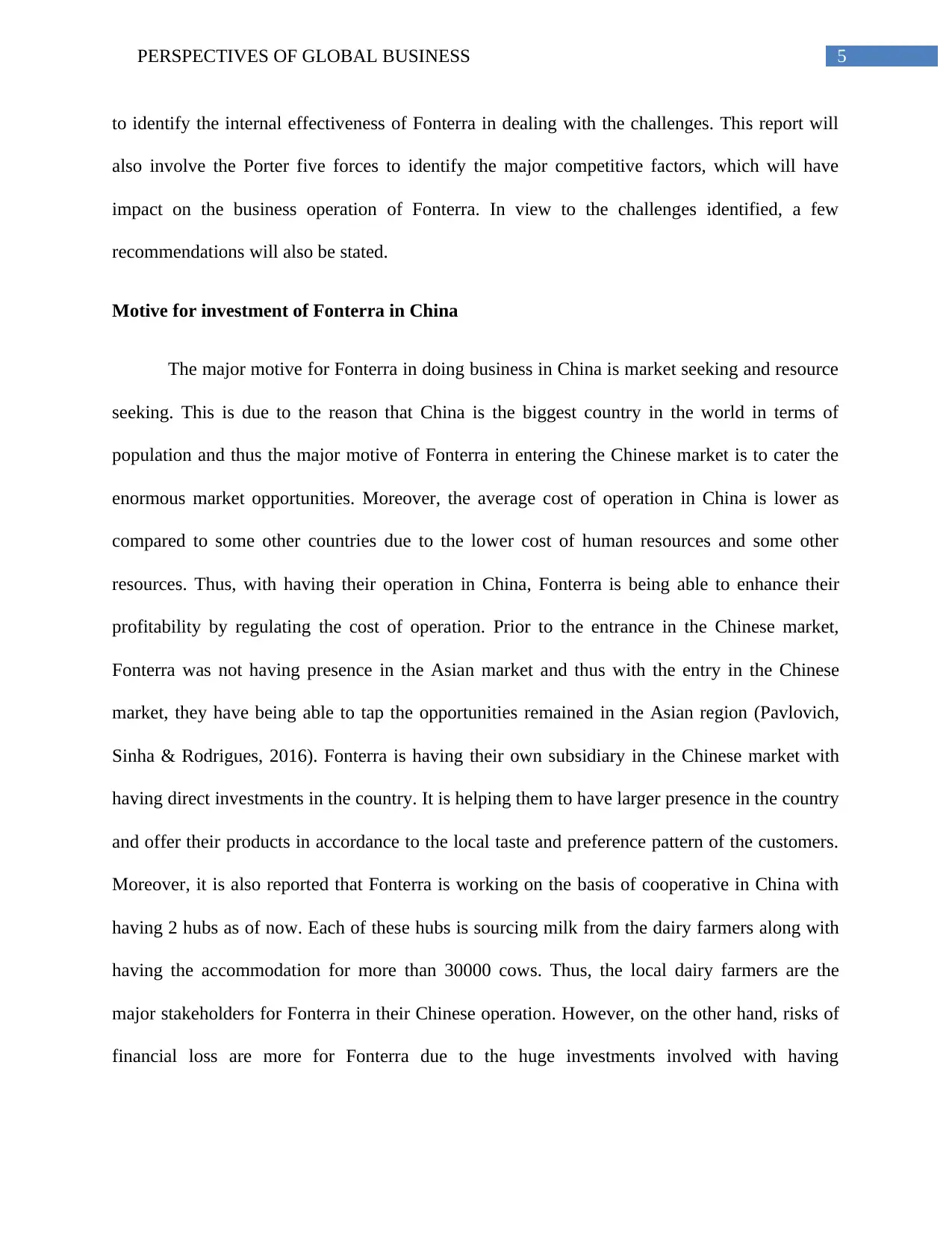
5PERSPECTIVES OF GLOBAL BUSINESS
to identify the internal effectiveness of Fonterra in dealing with the challenges. This report will
also involve the Porter five forces to identify the major competitive factors, which will have
impact on the business operation of Fonterra. In view to the challenges identified, a few
recommendations will also be stated.
Motive for investment of Fonterra in China
The major motive for Fonterra in doing business in China is market seeking and resource
seeking. This is due to the reason that China is the biggest country in the world in terms of
population and thus the major motive of Fonterra in entering the Chinese market is to cater the
enormous market opportunities. Moreover, the average cost of operation in China is lower as
compared to some other countries due to the lower cost of human resources and some other
resources. Thus, with having their operation in China, Fonterra is being able to enhance their
profitability by regulating the cost of operation. Prior to the entrance in the Chinese market,
Fonterra was not having presence in the Asian market and thus with the entry in the Chinese
market, they have being able to tap the opportunities remained in the Asian region (Pavlovich,
Sinha & Rodrigues, 2016). Fonterra is having their own subsidiary in the Chinese market with
having direct investments in the country. It is helping them to have larger presence in the country
and offer their products in accordance to the local taste and preference pattern of the customers.
Moreover, it is also reported that Fonterra is working on the basis of cooperative in China with
having 2 hubs as of now. Each of these hubs is sourcing milk from the dairy farmers along with
having the accommodation for more than 30000 cows. Thus, the local dairy farmers are the
major stakeholders for Fonterra in their Chinese operation. However, on the other hand, risks of
financial loss are more for Fonterra due to the huge investments involved with having
to identify the internal effectiveness of Fonterra in dealing with the challenges. This report will
also involve the Porter five forces to identify the major competitive factors, which will have
impact on the business operation of Fonterra. In view to the challenges identified, a few
recommendations will also be stated.
Motive for investment of Fonterra in China
The major motive for Fonterra in doing business in China is market seeking and resource
seeking. This is due to the reason that China is the biggest country in the world in terms of
population and thus the major motive of Fonterra in entering the Chinese market is to cater the
enormous market opportunities. Moreover, the average cost of operation in China is lower as
compared to some other countries due to the lower cost of human resources and some other
resources. Thus, with having their operation in China, Fonterra is being able to enhance their
profitability by regulating the cost of operation. Prior to the entrance in the Chinese market,
Fonterra was not having presence in the Asian market and thus with the entry in the Chinese
market, they have being able to tap the opportunities remained in the Asian region (Pavlovich,
Sinha & Rodrigues, 2016). Fonterra is having their own subsidiary in the Chinese market with
having direct investments in the country. It is helping them to have larger presence in the country
and offer their products in accordance to the local taste and preference pattern of the customers.
Moreover, it is also reported that Fonterra is working on the basis of cooperative in China with
having 2 hubs as of now. Each of these hubs is sourcing milk from the dairy farmers along with
having the accommodation for more than 30000 cows. Thus, the local dairy farmers are the
major stakeholders for Fonterra in their Chinese operation. However, on the other hand, risks of
financial loss are more for Fonterra due to the huge investments involved with having
⊘ This is a preview!⊘
Do you want full access?
Subscribe today to unlock all pages.

Trusted by 1+ million students worldwide
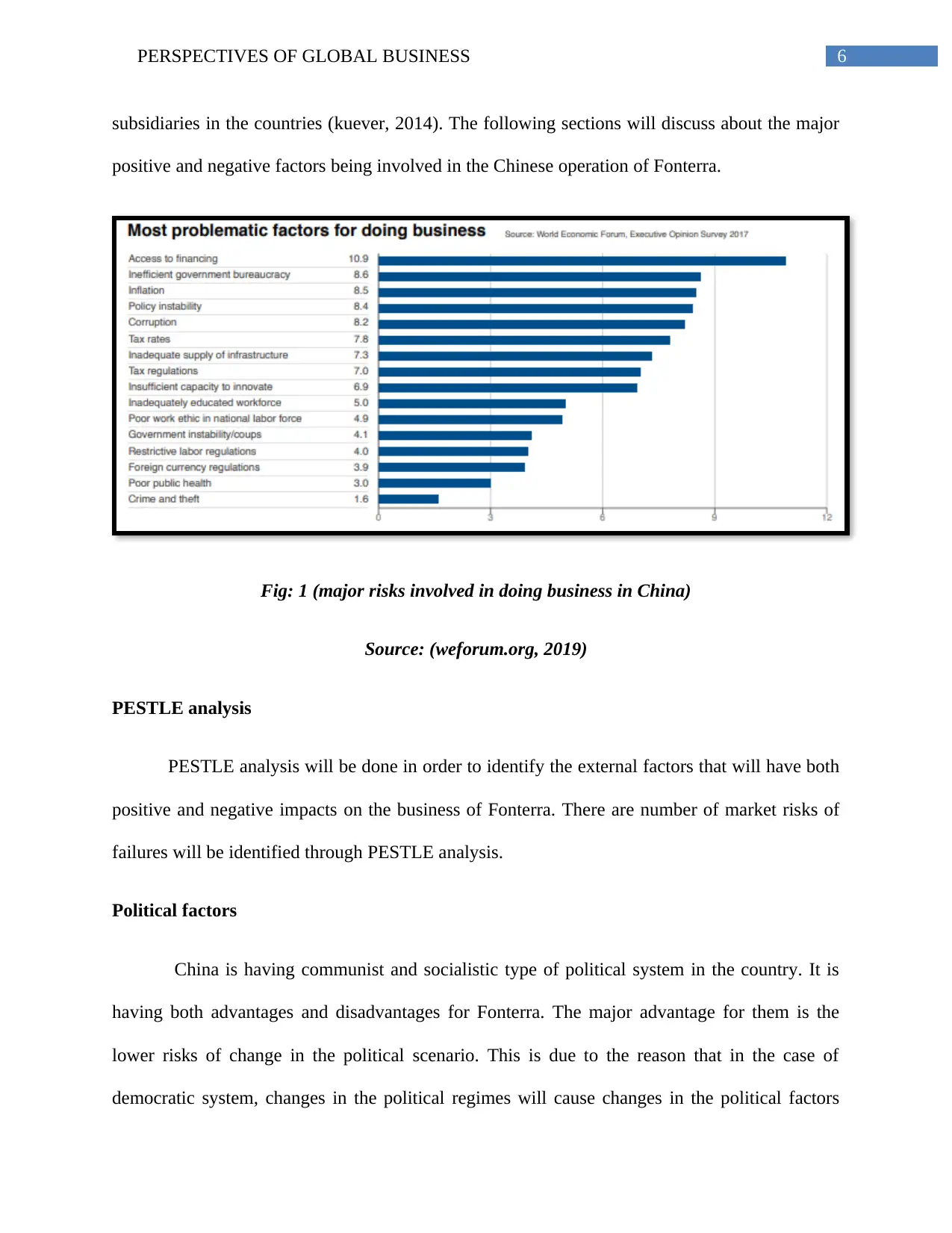
6PERSPECTIVES OF GLOBAL BUSINESS
subsidiaries in the countries (kuever, 2014). The following sections will discuss about the major
positive and negative factors being involved in the Chinese operation of Fonterra.
Fig: 1 (major risks involved in doing business in China)
Source: (weforum.org, 2019)
PESTLE analysis
PESTLE analysis will be done in order to identify the external factors that will have both
positive and negative impacts on the business of Fonterra. There are number of market risks of
failures will be identified through PESTLE analysis.
Political factors
China is having communist and socialistic type of political system in the country. It is
having both advantages and disadvantages for Fonterra. The major advantage for them is the
lower risks of change in the political scenario. This is due to the reason that in the case of
democratic system, changes in the political regimes will cause changes in the political factors
subsidiaries in the countries (kuever, 2014). The following sections will discuss about the major
positive and negative factors being involved in the Chinese operation of Fonterra.
Fig: 1 (major risks involved in doing business in China)
Source: (weforum.org, 2019)
PESTLE analysis
PESTLE analysis will be done in order to identify the external factors that will have both
positive and negative impacts on the business of Fonterra. There are number of market risks of
failures will be identified through PESTLE analysis.
Political factors
China is having communist and socialistic type of political system in the country. It is
having both advantages and disadvantages for Fonterra. The major advantage for them is the
lower risks of change in the political scenario. This is due to the reason that in the case of
democratic system, changes in the political regimes will cause changes in the political factors
Paraphrase This Document
Need a fresh take? Get an instant paraphrase of this document with our AI Paraphraser
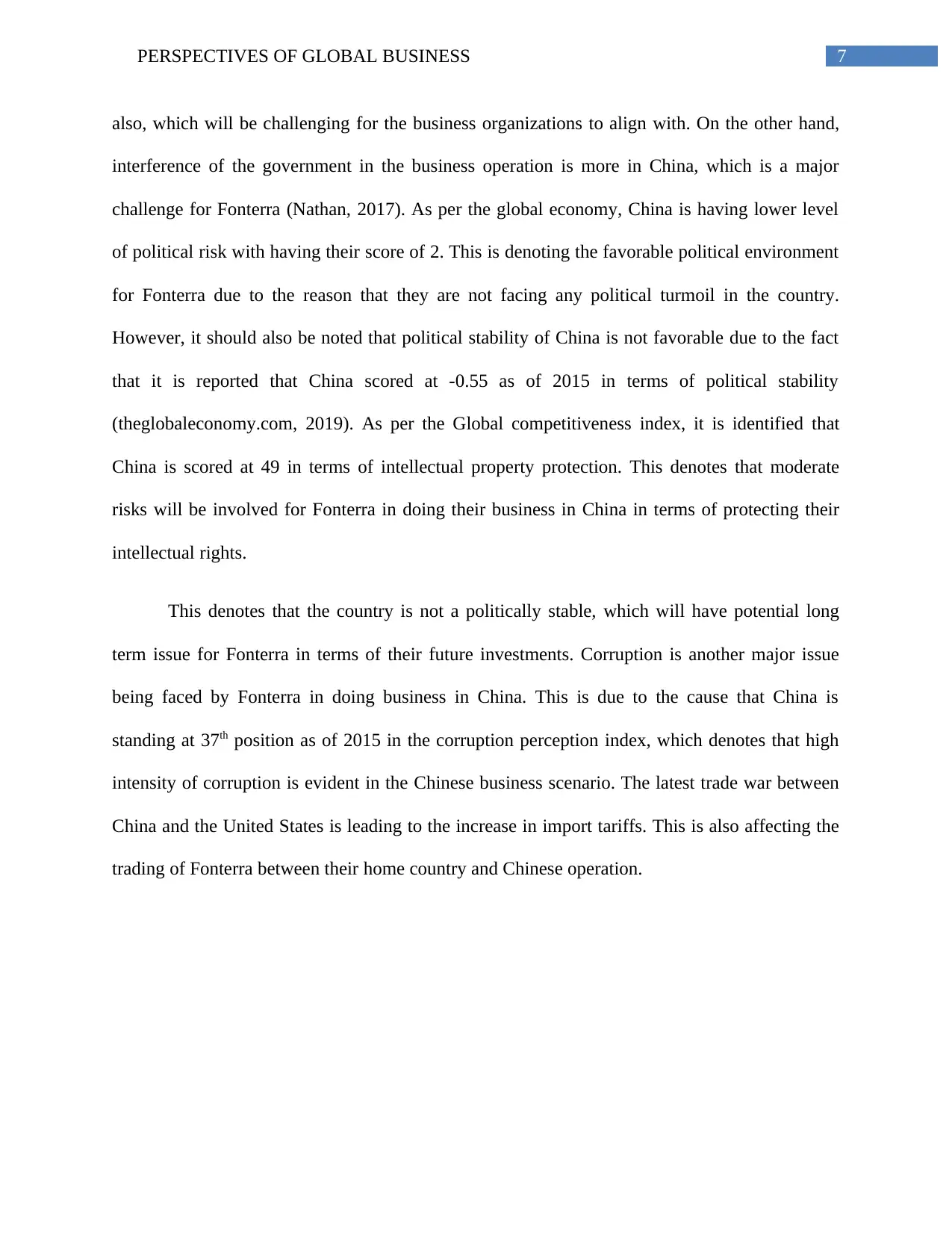
7PERSPECTIVES OF GLOBAL BUSINESS
also, which will be challenging for the business organizations to align with. On the other hand,
interference of the government in the business operation is more in China, which is a major
challenge for Fonterra (Nathan, 2017). As per the global economy, China is having lower level
of political risk with having their score of 2. This is denoting the favorable political environment
for Fonterra due to the reason that they are not facing any political turmoil in the country.
However, it should also be noted that political stability of China is not favorable due to the fact
that it is reported that China scored at -0.55 as of 2015 in terms of political stability
(theglobaleconomy.com, 2019). As per the Global competitiveness index, it is identified that
China is scored at 49 in terms of intellectual property protection. This denotes that moderate
risks will be involved for Fonterra in doing their business in China in terms of protecting their
intellectual rights.
This denotes that the country is not a politically stable, which will have potential long
term issue for Fonterra in terms of their future investments. Corruption is another major issue
being faced by Fonterra in doing business in China. This is due to the cause that China is
standing at 37th position as of 2015 in the corruption perception index, which denotes that high
intensity of corruption is evident in the Chinese business scenario. The latest trade war between
China and the United States is leading to the increase in import tariffs. This is also affecting the
trading of Fonterra between their home country and Chinese operation.
also, which will be challenging for the business organizations to align with. On the other hand,
interference of the government in the business operation is more in China, which is a major
challenge for Fonterra (Nathan, 2017). As per the global economy, China is having lower level
of political risk with having their score of 2. This is denoting the favorable political environment
for Fonterra due to the reason that they are not facing any political turmoil in the country.
However, it should also be noted that political stability of China is not favorable due to the fact
that it is reported that China scored at -0.55 as of 2015 in terms of political stability
(theglobaleconomy.com, 2019). As per the Global competitiveness index, it is identified that
China is scored at 49 in terms of intellectual property protection. This denotes that moderate
risks will be involved for Fonterra in doing their business in China in terms of protecting their
intellectual rights.
This denotes that the country is not a politically stable, which will have potential long
term issue for Fonterra in terms of their future investments. Corruption is another major issue
being faced by Fonterra in doing business in China. This is due to the cause that China is
standing at 37th position as of 2015 in the corruption perception index, which denotes that high
intensity of corruption is evident in the Chinese business scenario. The latest trade war between
China and the United States is leading to the increase in import tariffs. This is also affecting the
trading of Fonterra between their home country and Chinese operation.
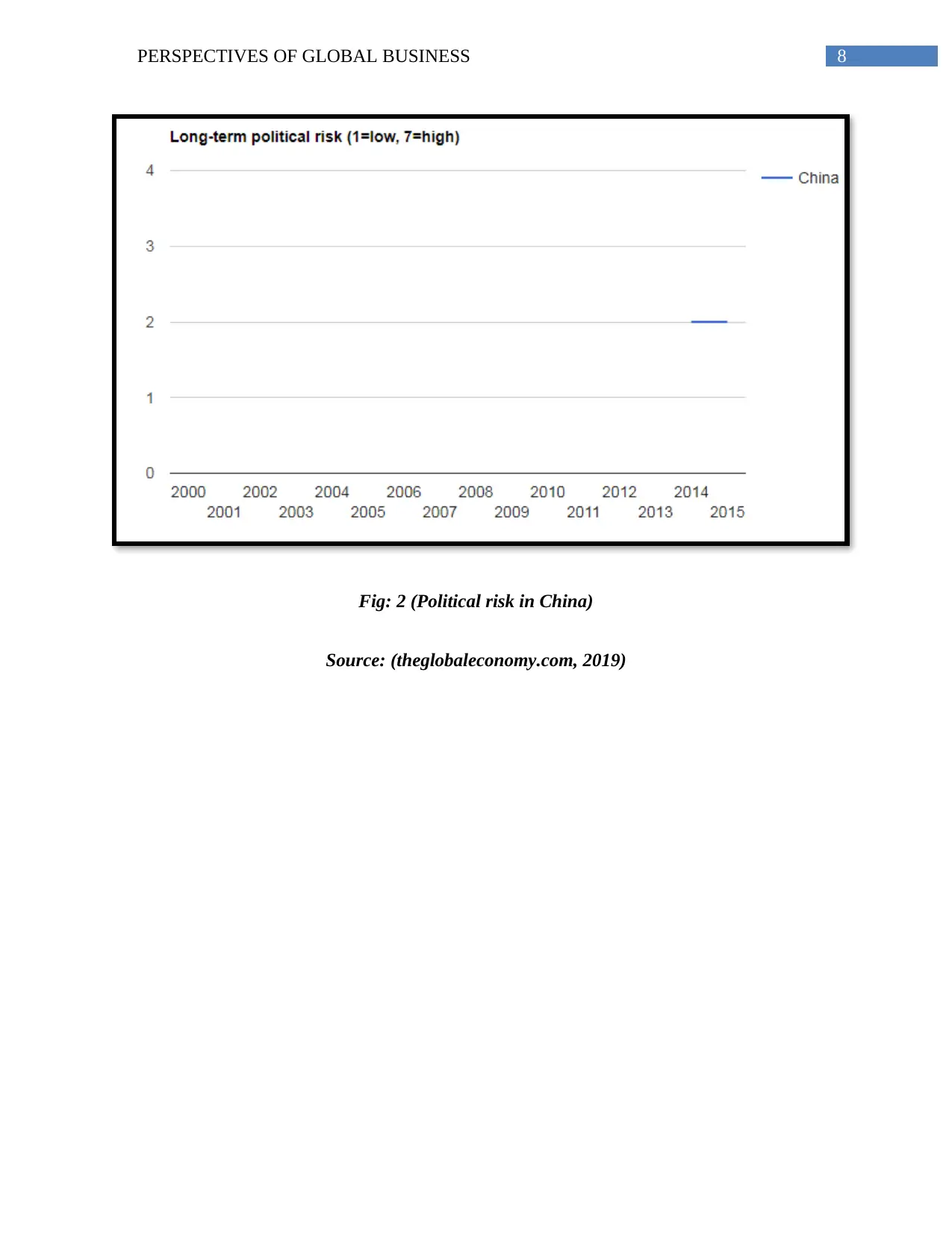
8PERSPECTIVES OF GLOBAL BUSINESS
Fig: 2 (Political risk in China)
Source: (theglobaleconomy.com, 2019)
Fig: 2 (Political risk in China)
Source: (theglobaleconomy.com, 2019)
⊘ This is a preview!⊘
Do you want full access?
Subscribe today to unlock all pages.

Trusted by 1+ million students worldwide
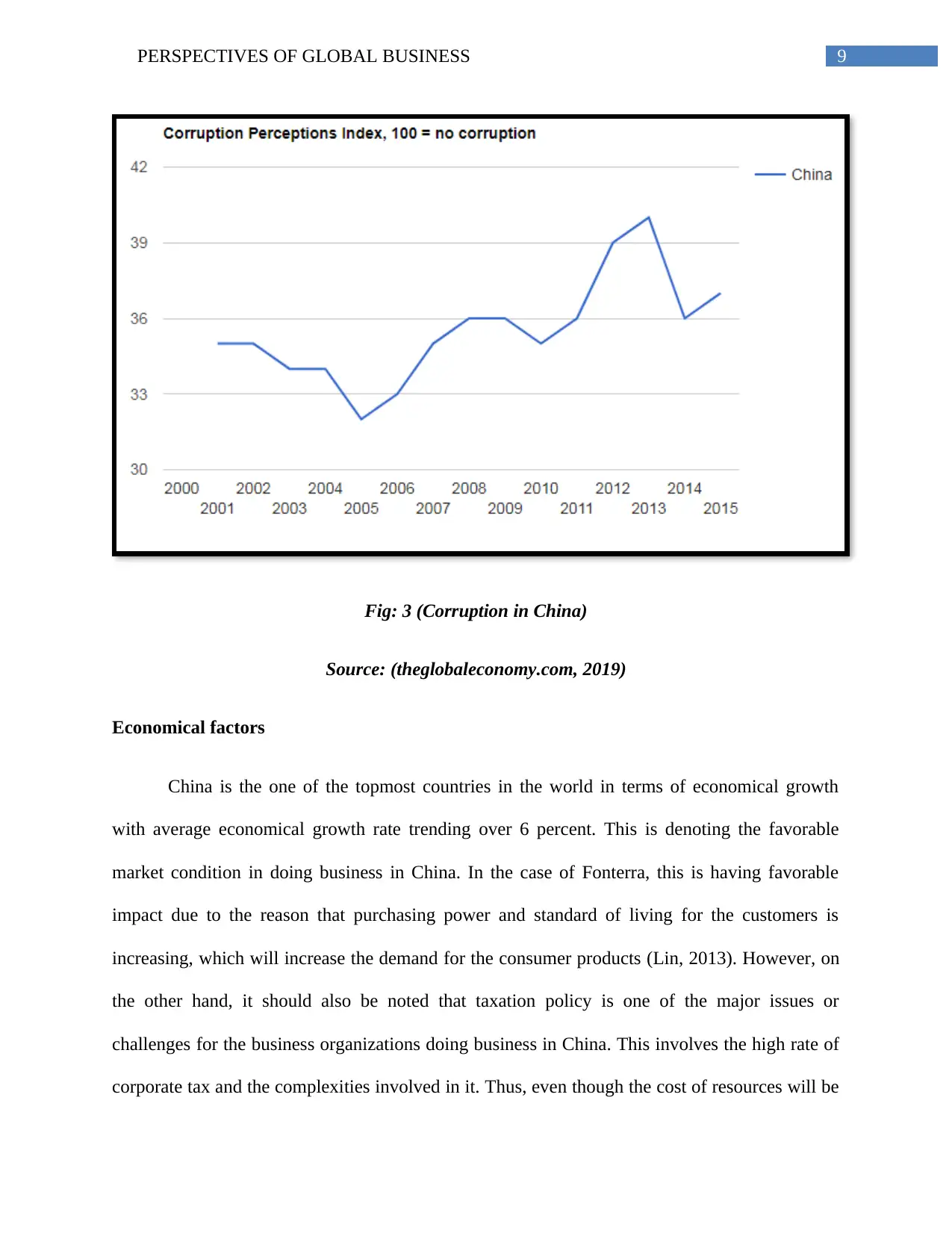
9PERSPECTIVES OF GLOBAL BUSINESS
Fig: 3 (Corruption in China)
Source: (theglobaleconomy.com, 2019)
Economical factors
China is the one of the topmost countries in the world in terms of economical growth
with average economical growth rate trending over 6 percent. This is denoting the favorable
market condition in doing business in China. In the case of Fonterra, this is having favorable
impact due to the reason that purchasing power and standard of living for the customers is
increasing, which will increase the demand for the consumer products (Lin, 2013). However, on
the other hand, it should also be noted that taxation policy is one of the major issues or
challenges for the business organizations doing business in China. This involves the high rate of
corporate tax and the complexities involved in it. Thus, even though the cost of resources will be
Fig: 3 (Corruption in China)
Source: (theglobaleconomy.com, 2019)
Economical factors
China is the one of the topmost countries in the world in terms of economical growth
with average economical growth rate trending over 6 percent. This is denoting the favorable
market condition in doing business in China. In the case of Fonterra, this is having favorable
impact due to the reason that purchasing power and standard of living for the customers is
increasing, which will increase the demand for the consumer products (Lin, 2013). However, on
the other hand, it should also be noted that taxation policy is one of the major issues or
challenges for the business organizations doing business in China. This involves the high rate of
corporate tax and the complexities involved in it. Thus, even though the cost of resources will be
Paraphrase This Document
Need a fresh take? Get an instant paraphrase of this document with our AI Paraphraser
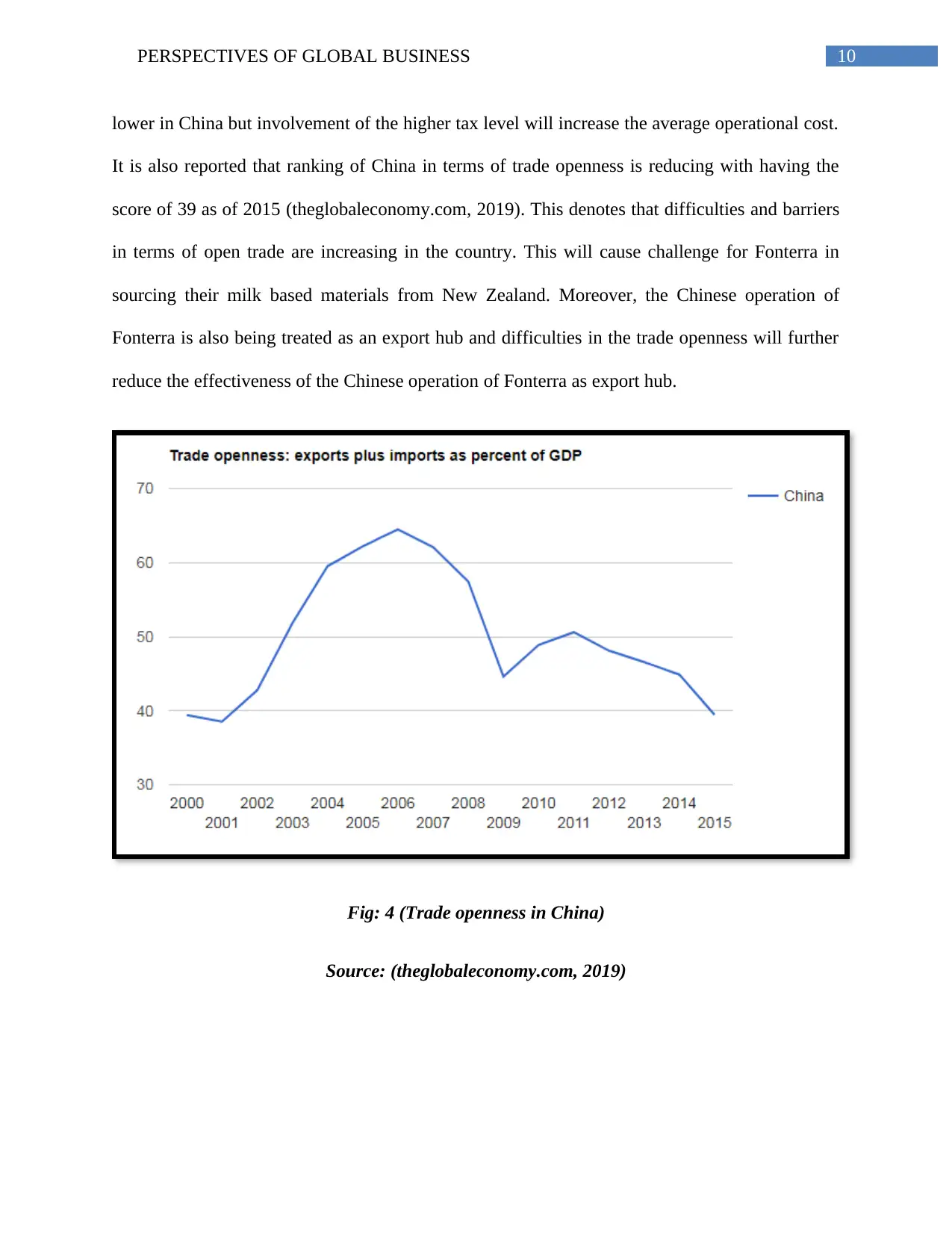
10PERSPECTIVES OF GLOBAL BUSINESS
lower in China but involvement of the higher tax level will increase the average operational cost.
It is also reported that ranking of China in terms of trade openness is reducing with having the
score of 39 as of 2015 (theglobaleconomy.com, 2019). This denotes that difficulties and barriers
in terms of open trade are increasing in the country. This will cause challenge for Fonterra in
sourcing their milk based materials from New Zealand. Moreover, the Chinese operation of
Fonterra is also being treated as an export hub and difficulties in the trade openness will further
reduce the effectiveness of the Chinese operation of Fonterra as export hub.
Fig: 4 (Trade openness in China)
Source: (theglobaleconomy.com, 2019)
lower in China but involvement of the higher tax level will increase the average operational cost.
It is also reported that ranking of China in terms of trade openness is reducing with having the
score of 39 as of 2015 (theglobaleconomy.com, 2019). This denotes that difficulties and barriers
in terms of open trade are increasing in the country. This will cause challenge for Fonterra in
sourcing their milk based materials from New Zealand. Moreover, the Chinese operation of
Fonterra is also being treated as an export hub and difficulties in the trade openness will further
reduce the effectiveness of the Chinese operation of Fonterra as export hub.
Fig: 4 (Trade openness in China)
Source: (theglobaleconomy.com, 2019)
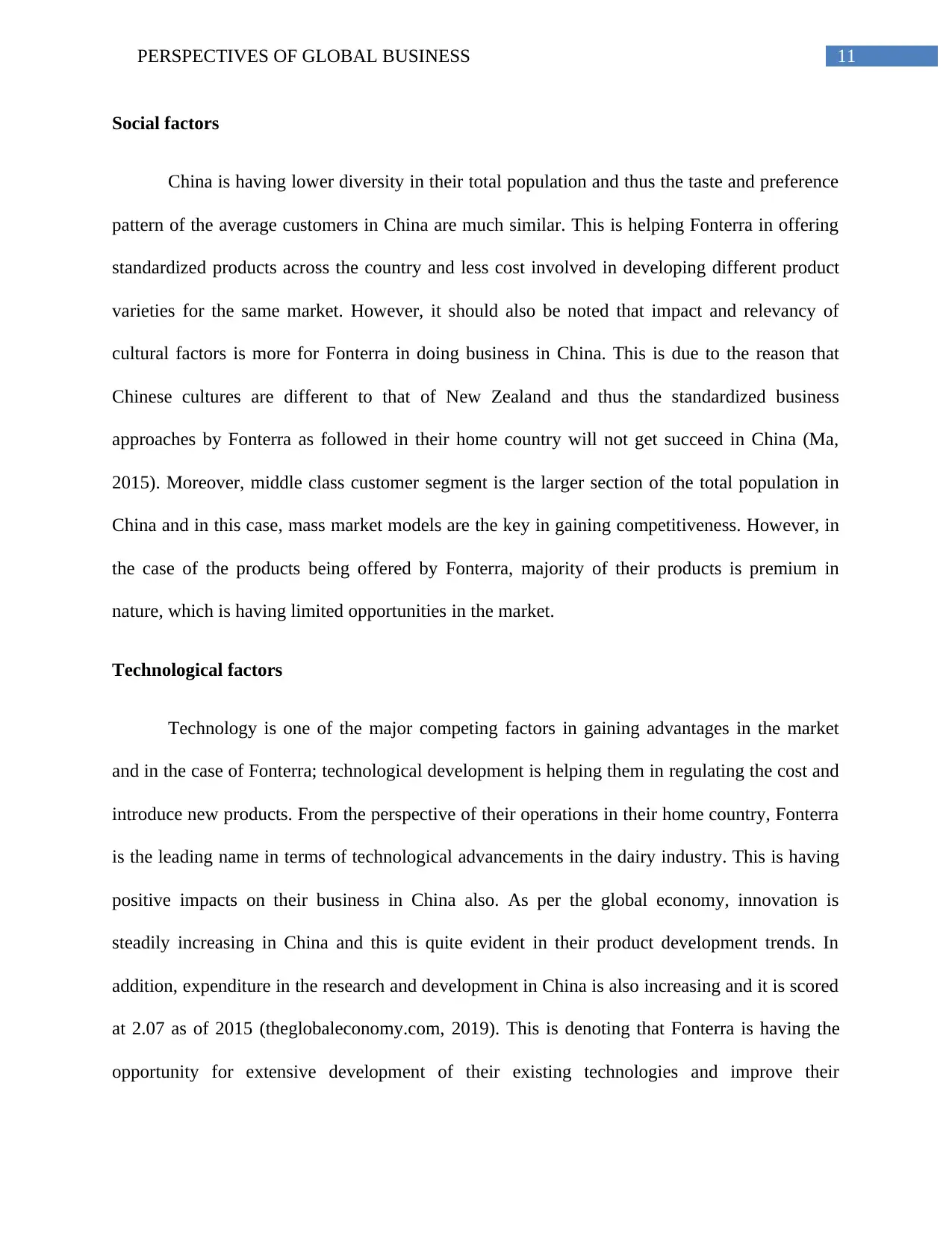
11PERSPECTIVES OF GLOBAL BUSINESS
Social factors
China is having lower diversity in their total population and thus the taste and preference
pattern of the average customers in China are much similar. This is helping Fonterra in offering
standardized products across the country and less cost involved in developing different product
varieties for the same market. However, it should also be noted that impact and relevancy of
cultural factors is more for Fonterra in doing business in China. This is due to the reason that
Chinese cultures are different to that of New Zealand and thus the standardized business
approaches by Fonterra as followed in their home country will not get succeed in China (Ma,
2015). Moreover, middle class customer segment is the larger section of the total population in
China and in this case, mass market models are the key in gaining competitiveness. However, in
the case of the products being offered by Fonterra, majority of their products is premium in
nature, which is having limited opportunities in the market.
Technological factors
Technology is one of the major competing factors in gaining advantages in the market
and in the case of Fonterra; technological development is helping them in regulating the cost and
introduce new products. From the perspective of their operations in their home country, Fonterra
is the leading name in terms of technological advancements in the dairy industry. This is having
positive impacts on their business in China also. As per the global economy, innovation is
steadily increasing in China and this is quite evident in their product development trends. In
addition, expenditure in the research and development in China is also increasing and it is scored
at 2.07 as of 2015 (theglobaleconomy.com, 2019). This is denoting that Fonterra is having the
opportunity for extensive development of their existing technologies and improve their
Social factors
China is having lower diversity in their total population and thus the taste and preference
pattern of the average customers in China are much similar. This is helping Fonterra in offering
standardized products across the country and less cost involved in developing different product
varieties for the same market. However, it should also be noted that impact and relevancy of
cultural factors is more for Fonterra in doing business in China. This is due to the reason that
Chinese cultures are different to that of New Zealand and thus the standardized business
approaches by Fonterra as followed in their home country will not get succeed in China (Ma,
2015). Moreover, middle class customer segment is the larger section of the total population in
China and in this case, mass market models are the key in gaining competitiveness. However, in
the case of the products being offered by Fonterra, majority of their products is premium in
nature, which is having limited opportunities in the market.
Technological factors
Technology is one of the major competing factors in gaining advantages in the market
and in the case of Fonterra; technological development is helping them in regulating the cost and
introduce new products. From the perspective of their operations in their home country, Fonterra
is the leading name in terms of technological advancements in the dairy industry. This is having
positive impacts on their business in China also. As per the global economy, innovation is
steadily increasing in China and this is quite evident in their product development trends. In
addition, expenditure in the research and development in China is also increasing and it is scored
at 2.07 as of 2015 (theglobaleconomy.com, 2019). This is denoting that Fonterra is having the
opportunity for extensive development of their existing technologies and improve their
⊘ This is a preview!⊘
Do you want full access?
Subscribe today to unlock all pages.

Trusted by 1+ million students worldwide
1 out of 21
Related Documents
Your All-in-One AI-Powered Toolkit for Academic Success.
+13062052269
info@desklib.com
Available 24*7 on WhatsApp / Email
![[object Object]](/_next/static/media/star-bottom.7253800d.svg)
Unlock your academic potential
Copyright © 2020–2025 A2Z Services. All Rights Reserved. Developed and managed by ZUCOL.





